![]()
 |
cis-3-HEXENAL, trans-2-HEXENAL |
 |
![]()
Simon Cotton
Uppingham School, Rutland, UK
![]()
Also available: HTML only, VRML and Jmol versions.
![]()
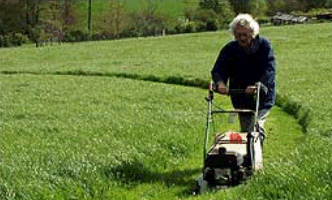

cis-3-hexenal is the key aroma substance emitted when grass is cut and other types of vegetation are damaged. It has a very low odour threshold of 0.25 parts per billion.
cis-3-hexenal |
 trans-2-hexenal |
The Odour Threshold is the lowest concentration of a vapour in air which can be detected by smell.
 Can you bottle it?
Can you bottle it?Unfortunately, cis-3-hexenal is unstable and tends to rearrange to the more stable trans-2-hexenal ("leaf aldehyde"), which has an odour threshold of 17 ppb. The related cis-3-hexen-1-ol ("leaf alcohol") has an odour threshold of 70 ppb - it's used in perfumes.
When grass is cut, breakdown of fats and phospholipids leads to α-linolenic acid (and lineoleic acid). This is oxidised to 12-hydroperoxylinoleinic acid by a lipoxygenase enzyme. In turn, the C18 chain in this molecules is split by another enzyme, hydroperoxide lyase , usually into C6 and C12 fragments. The initial C6 product is cis-hex-3-enal (3E-hexenal).
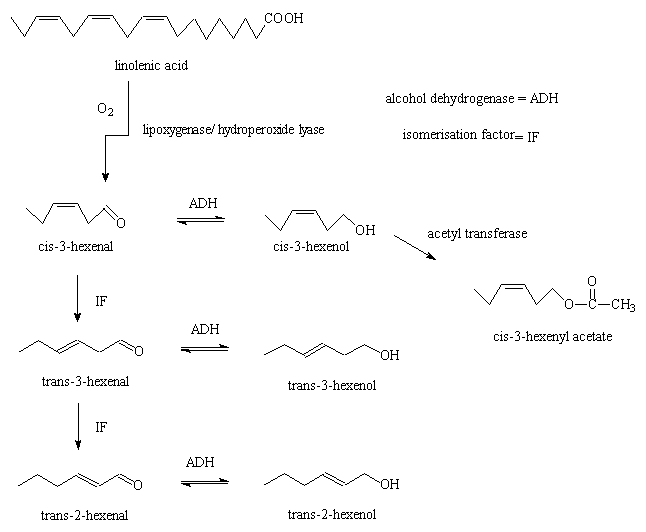
One may be in protecting the plant from bacteria, for example, allowing the cut ends to heal. trans-2-hexenal is one of a number of aldehydes found in coriander, widely used in cooking. Spices have long been associated with preserving food, and both trans-2-hexenal and trans-3-hexenal have been found to be active against a range of bacteria, including Salmonella choleraesuis (the most common cause of septicaemia).
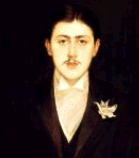 There is no doubt that smell taps into our memories and into subconscious emotions. The classic example linking smell with memory occurs in the masterpiece of the French novelist Marcel Proust (1871-1922, right), "A la Recherche du Temps Perdu" ("In Search of Lost Time"). Very early on, in the first book ("Swann's Way"), the protagonist Charles Swann found that the smell from a piece of a small madeleine cake soaked in tea acted as the trigger for a whole raft of memories from his childhood. On Sunday mornings at Illiers, near Chartres (Combray in the novel), Proust would go to the bedroom of his aunt Elizabeth (Léonie, in the novel) to say good morning, before Mass, and she would give him a small piece of madeleine that had been dipped in her cup of lime blossom tea.
There is no doubt that smell taps into our memories and into subconscious emotions. The classic example linking smell with memory occurs in the masterpiece of the French novelist Marcel Proust (1871-1922, right), "A la Recherche du Temps Perdu" ("In Search of Lost Time"). Very early on, in the first book ("Swann's Way"), the protagonist Charles Swann found that the smell from a piece of a small madeleine cake soaked in tea acted as the trigger for a whole raft of memories from his childhood. On Sunday mornings at Illiers, near Chartres (Combray in the novel), Proust would go to the bedroom of his aunt Elizabeth (Léonie, in the novel) to say good morning, before Mass, and she would give him a small piece of madeleine that had been dipped in her cup of lime blossom tea.
 Players of the traditional English summer game, cricket, are familiar with the smell of cut grass. It is very potent. Alan Dixon played first class cricket for Kent. He was an all-rounder, both a middle-order batsman and a bowler at medium pace and of off-spinners. He decided to retire in the autumn of 1957 at the age of 23 as he was not sure of a place in the First XI. He went off to become a travelling salesman.
Players of the traditional English summer game, cricket, are familiar with the smell of cut grass. It is very potent. Alan Dixon played first class cricket for Kent. He was an all-rounder, both a middle-order batsman and a bowler at medium pace and of off-spinners. He decided to retire in the autumn of 1957 at the age of 23 as he was not sure of a place in the First XI. He went off to become a travelling salesman.
"But it came round to the spring [1958], and I stopped the car by a cricket field where they were mowing the grass. And the smell of that new-mown grass meant so much. I got out of my car and rang Les Ames [the Secretary of Kent County Cricket Club]. 'Leslie,' I said, 'it looks as if I've made a mistake'".
Dixon played for another 13 seasons and did not retire until 1970, when he was a member of the Kent XI that won the County Championship.
![Smelling a flower [from: http://health.yahoo.co.jp/images/topics_f/20020511/smell.jpg]](smellflower.gif) How does it work?
How does it work?We are hot-wired for memory. Olfaction is closely linked with the limbic system, of which the hippocampus and amygdala are a part, and which is responsible for emotions and memory. The sense of smell has a direct link to the cerebral cortex in the brain; messages involving other senses like touch or taste have a more circuitous route. How the message gets through is another matter, with both the traditional "lock and key" theory and the "vibrational" theory linking molecules and smell currently in vogue.
Tom Jones for one, in "Green Green Grass Of Home" and the Inkspots, with "Whispering Grass".
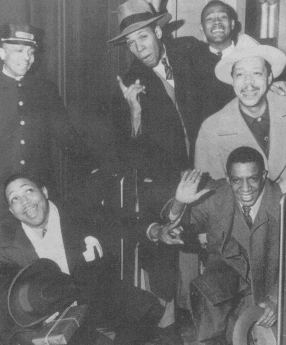 The Inkspots |
 Tom Jones |
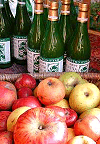 Where else do these molecules occur?
Where else do these molecules occur?trans-2-hexenal, and hexyl acetate are chief among molecules responsible for the freshness of apple juice flavour, and thus hexenals can be used as additives to make flavours have a greener texture. Animals use them too.
The Japanese scarab beetle, Phyllopertha diversa, has olfactory receptor neurones that are specific for green-leaf volatiles, namely trans-2-hexenal, cis-3-hexenyl acetate, and cis-3-hexenol.
Some ants use trans-2-hexenal as an alarm pheromone.
 Stink bugs, important agricultural predators (picture, right), use trans-2-hexenal as a attractant and pheromone, and it is a potential weapon to protect crops.
Stink bugs, important agricultural predators (picture, right), use trans-2-hexenal as a attractant and pheromone, and it is a potential weapon to protect crops.
Green leaf volatiles, including trans-2-hexenal, disrupt responses by the spruce beetle, Dendroctonus rufipennis, and the western pine beetle, Dendroctonus brevicomis to attractant-baited traps.
 Behavioural studies involving PET (Positron emission tomography) have shown that the "green odour" mixture of trans-2-hexenal and cis-3-hexen-1-ol has a healing effect on the psychological damage caused by stress. The mixture activates regional blood flow in the primary olfactory cortex (like other smelly molecules) and also the anterior cingulated gyrus, the latter being linked with the "healing effect".
Behavioural studies involving PET (Positron emission tomography) have shown that the "green odour" mixture of trans-2-hexenal and cis-3-hexen-1-ol has a healing effect on the psychological damage caused by stress. The mixture activates regional blood flow in the primary olfactory cortex (like other smelly molecules) and also the anterior cingulated gyrus, the latter being linked with the "healing effect".
![]()